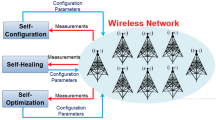Abstract
Spectrum sensing is a crucial task for a cognitive radio system. It enables cognitive radio to identify vacant frequency bands and to opportunistically access spectrum. Thus, reliable detection of primary users is important since the cognitive radio (CR) operating as a secondary system is not allowed to cause harmful interference to PUs. In this paper, an effective generalized likelihood ratio test (GLRT) based on power method (named as P-GLRT algorithm) is proposed for cooperative spectrum sensing. Compared with the previous works, the presented method offers a number of advantages over other recently proposed algorithms. Firstly, it can solve the problem of uncertain noise and lower signal-to-noise ratio. Secondly, it requires no prior knowledge of the transmitted signal, the wireless channel gains from the primary transmitter to the CR receiver, and the noise variance. Finally, the proposed approach makes use of power method to obtain the maximum eigenvalue and the corresponding eigenvector for maximum likelihood estimates of unknown parameters, it avoids the eigenvalue decomposition processing. Simulation results show the proposed algorithm has better detection performance than other relevant methods. Meanwhile, some performance analysis of the proposed algorithm via simulations are presented.



Similar content being viewed by others
References
Federal Communications Commission. (2002). Spectrum policy task force report.
Mitola, J., & Maguire, G. Q. (1999). Cognitive radio: Making software radios more personal. IEEE Personal Communications, 6(4), 13–18.
Haykin, S. (2009). Dynamic spectrum management for cognitive radio: An overview. Wireless Communications and Mobile Computing, 9(11), 1447–1459.
Haykin, S., Thomson, D. J., & Reed, J. H. (2009). Spectrum sensing for cognitive radio. Proceedings of the IEEE, 97(5), 849–877.
Singh, A., Bhatnagar, M. R., & Mallik, R. K. (2012). Cooperative spectrum sensing in multiple antenna based cognitive radio network using an improved energy detector. IEEE Communications Letters, 16(1), 64–67.
Hammouda, M. A., & Wallace, J. W. (2012). Noise uncertainty in cognitive radio sensing: Analytical modeling and detection performance. In International ITG workshop on smart antennas (WSA) (pp. 287–93).
Liu, F. L., Guo, S. M., & Du, R. Y. (2012). An effective wideband spectrum sensing method based on sparse signal reconstruction for cognitive radio networks. Progress in Electromagnetics Research C, 28, 99–111.
Taherpour, A., Nasiri-Kenari, M., & Gazor, S. (2010). Multiple antenna spectrum sensing in cognitive radios. IEEE Transactions on Wireless Communications, 9(2), 814–823.
Zhang, R., Lim, T., Liang, Y. C., & Zeng, Y. (2010). Multi-antenna based spectrum sensing for cognitive radios: A GLRT approach. IEEE Transactions on Communications, 58(1), 84–88.
Akyildiz, I. F., Lo, B. F., & Balakrishnan, R. (2011). Cooperative spectrum sensing in cognitive radio networks: A survey. Physical Communication, 4(1), 40–62.
Wang, S., Wang, Y., Coon, J., & Doufexi, A. (2011). Antenna selection based spectrum sensing for cognitive radio networks. In IEEE international symposium on personal, indoor and mobile radio communications (pp. 364–368).
Wang, L., Zheng, B. Y., Cui, J. W., & Chen, C. (2010). Cooperative MIMO spectrum sensing based on random matrix theory. Journal of Electronics (China), 27(2), 190–196.
Wang, P., Fang, J., Han, N., & Li, H. (2010). Multiantenna-assisted spectrum sensing for cognitive radio. IEEE Transactions on Vehicular Technology, 59(4), 1791–1800.
Tugnait, J. K. (2012). On multiple antenna spectrum sensing under noise variance uncertainty and flat fading. IEEE Transactions on Signal Processing, 60(4), 1823–32.
Zeng, Y. H., & Liang, Y. C. (2007). Maximum–minimum eigenvalue detection for cognitive radio. In IEEE international symposium on personal, indoor and mobile radio communications (pp. 1165–1169).
Acknowledgments
This work has been supported by the Program for New Century Excellent Talents in University (NCET-13-0105), and by the Support Program for Hundreds of Outstanding Innovative Talents in Higher Education Institutions of Hebei Province, under Grant No. BR2-259, and by the Fundamental Research Funds for the Central Universities under Grant No. N120423002, and by the Program for Liaoning Excellent Talents in University (LJQ2012022), and by Directive Plan of Science Research from the Bureau of Education of Hebei Province, China, under Grant No. Z2011129, and by the National Natural Science Foundation of China under Grant No. 60904035, and by the Specialized Research Fund for the Doctoral Program of Higher Education of China (No. 20130042110003). The authors also gratefully acknowledge the helpful comments and suggestions of the reviewers, which have significantly improved the presentation of this paper.
Author information
Authors and Affiliations
Corresponding author
Rights and permissions
About this article
Cite this article
Liu, F., Du, R., Guo, J. et al. P-GLRT Algorithm for Cooperative Spectrum Sensing. Wireless Pers Commun 81, 1079–1089 (2015). https://doi.org/10.1007/s11277-014-2172-6
Published:
Issue Date:
DOI: https://doi.org/10.1007/s11277-014-2172-6




